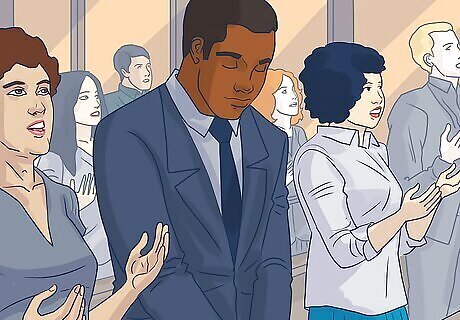
views
Arriving at the Funeral

Dress conservatively. When attending a funeral, always dress conservatively. Do not wear flashy outfits, bright colors, baggy clothing, or low-cutting blouses or dresses. You do not have to wear all black, but at least dress in darker colors, like dark blues, greens, and grays. As a general rule of thumb, dress business casual when attending funerals. Remember, a funeral is not the right time to make a fashion statement. However, if the dresscode states no black, avoid the colour entirely- men can still wear black trousers.

Arrive early. Try to attend the funeral 10 minutes early. This will enable you to find seating and sign the guest book. If you sign the guest book, be sure to sign your first and last name; you can also state your relationship to the deceased, e.g., friend, coworker, colleague, or teammate.

Don’t sit in the front rows. In general, the first several rows of seating are usually reserved for immediate family members, relatives, and close friends. If you are not a close friend, family, or relative, sit in the middle or in the back of the venue.
Behaving During the Service

Turn off distractions. It is recommended that you either keep your phone on silent in your purse or your pocket, or completely turn off your phone. You do not want to interrupt the service with a ringing cell phone. It is also considered poor taste to be on social media during a funeral, like Instagram, Twitter, Facebook, or Snapchat. Photography, unless authorized, is usually disapproved of during the funeral service. At the reception following the service, it may be okay to take photos if you are close to the family, especially if you haven't seen them in awhile. Ask before you snap a picture, and watch what others are doing.

Offer your condolences to the family. It is appropriate, and welcomed, for you to offer your condolences to the family. There are various ways to offer your condolences, but the conventional thing to do is to either send or bring flowers to the funeral, or you can verbally express your sincerest sympathies to the bereaved. The important thing is to act in a reserved manner. This means keeping your emotions in check, avoiding slang, and using a somber tone of voice. For example, when you approach the family, move at a slower pace than you might normally, keeping your facial expression neutral. In your most serious tone, say, "I'm so sorry for your loss. We're all going to miss her." Before bringing flowers to a funeral, check with the family members or with the funeral director if it is appropriate. You can offer your sympathies by saying, “I am very sorry for your loss” or “I am here for you and your family if you need anything.” If you are at a loss for words, you can simply offer a hug or bring a sympathy card.

Don’t be afraid to grieve. It is OK and acceptable to cry at funerals. Crying is a healthy, normal response. However, if you begin to cry uncontrollably or feel like you're about to experience a strong emotional reaction, excuse yourself until you can regain your composure.

Listen respectfully to the eulogy. While eulogies are a common procedure at funerals, not all funerals have eulogies. For example, in Roman Catholic and Anglican churches, eulogies are discouraged. However, if you are attending a funeral where someone gives a eulogy, listen respectfully to the eulogy. If you are distracted while the eulogy is taking place, others might take offense to this. Generally, laughing at funerals is unacceptable unless it is warranted. An occasion for when laughing is warranted is when the eulogizer recounts a funny memory about the deceased. However, stay on the safe side by following the family’s lead.

View the open casket only if you are comfortable. Some services might have an open casket. If this makes you uncomfortable, you are under no obligation to approach the casket. If you do want to approach the open casket, but think you might become emotional, consider asking someone to walk with you to the casket.
Attending a Religious Funeral

Learn about the religion's customs beforehand. There are times when you might find yourself attending a religious funeral, where you are unfamiliar with the religion's customs. In order to avoid embarrassing or inappropriate situations, do some research beforehand on the different customs for that religion. For example, it is unconventional to bring flowers to a Jewish funeral. For Catholic funerals, it is conventional to send a mass card to the family of the deceased.

Do what others do. If you are unsure about what is appropriate at a funeral service, do what others do; stand when people stand, and sit when people sit. It helps if you sit at the back of the venue so you can follow the other’s lead.

Don’t take offense by religion. Remember, you do not have to do anything you are uncomfortable with. If you are attending a religious funeral whose denomination you are not a member of, you do not have to sing or pray with everyone. Instead, bow your head in a respectful manner as if you are reflecting.
















Comments
0 comment